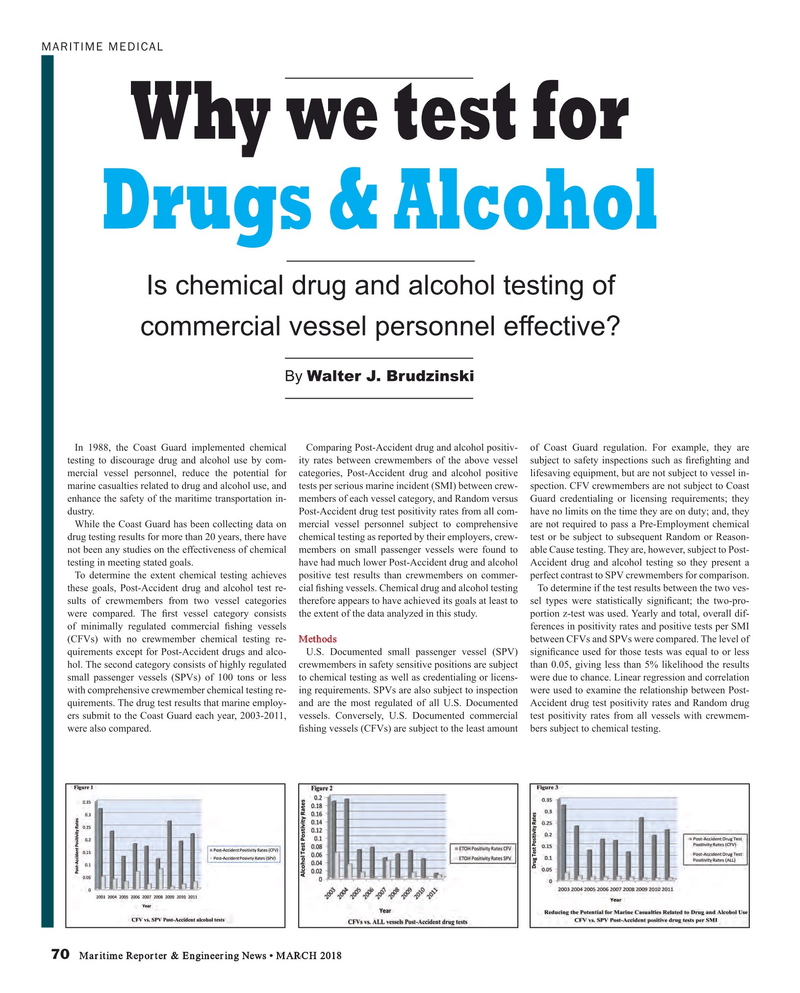
Page 70: of Maritime Reporter Magazine (March 2018)
Annual World Yearbook
Read this page in Pdf, Flash or Html5 edition of March 2018 Maritime Reporter Magazine
MARITIME MEDICAL
Why we test for
Drugs & Alcohol
Is chemical drug and alcohol testing of commercial vessel personnel effective?
By Walter J. Brudzinski
In 1988, the Coast Guard implemented chemical Comparing Post-Accident drug and alcohol positiv- of Coast Guard regulation. For example, they are testing to discourage drug and alcohol use by com- ity rates between crewmembers of the above vessel subject to safety inspections such as ? re? ghting and mercial vessel personnel, reduce the potential for categories, Post-Accident drug and alcohol positive lifesaving equipment, but are not subject to vessel in- marine casualties related to drug and alcohol use, and tests per serious marine incident (SMI) between crew- spection. CFV crewmembers are not subject to Coast enhance the safety of the maritime transportation in- members of each vessel category, and Random versus Guard credentialing or licensing requirements; they dustry. Post-Accident drug test positivity rates from all com- have no limits on the time they are on duty; and, they
While the Coast Guard has been collecting data on mercial vessel personnel subject to comprehensive are not required to pass a Pre-Employment chemical drug testing results for more than 20 years, there have chemical testing as reported by their employers, crew- test or be subject to subsequent Random or Reason- not been any studies on the effectiveness of chemical members on small passenger vessels were found to able Cause testing. They are, however, subject to Post- testing in meeting stated goals. have had much lower Post-Accident drug and alcohol Accident drug and alcohol testing so they present a
To determine the extent chemical testing achieves positive test results than crewmembers on commer- perfect contrast to SPV crewmembers for comparison. these goals, Post-Accident drug and alcohol test re- cial ? shing vessels. Chemical drug and alcohol testing To determine if the test results between the two ves- sults of crewmembers from two vessel categories therefore appears to have achieved its goals at least to sel types were statistically signi? cant; the two-pro- were compared. The ? rst vessel category consists the extent of the data analyzed in this study. portion z-test was used. Yearly and total, overall dif- of minimally regulated commercial ? shing vessels ferences in positivity rates and positive tests per SMI (CFVs) with no crewmember chemical testing re- Methods between CFVs and SPVs were compared. The level of quirements except for Post-Accident drugs and alco- U.S. Documented small passenger vessel (SPV) signi? cance used for those tests was equal to or less hol. The second category consists of highly regulated crewmembers in safety sensitive positions are subject than 0.05, giving less than 5% likelihood the results small passenger vessels (SPVs) of 100 tons or less to chemical testing as well as credentialing or licens- were due to chance. Linear regression and correlation with comprehensive crewmember chemical testing re- ing requirements. SPVs are also subject to inspection were used to examine the relationship between Post- quirements. The drug test results that marine employ- and are the most regulated of all U.S. Documented Accident drug test positivity rates and Random drug ers submit to the Coast Guard each year, 2003-2011, vessels. Conversely, U.S. Documented commercial test positivity rates from all vessels with crewmem- were also compared. ? shing vessels (CFVs) are subject to the least amount bers subject to chemical testing. 70 Maritime Reporter & Engineering News • MARCH 2018
MR #3 (66-73).indd 70 MR #3 (66-73).indd 70 3/7/2018 9:10:47 AM3/7/2018 9:10:47 AM

 69
69

 71
71
